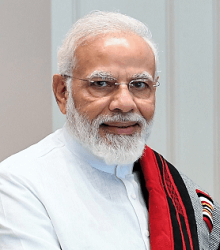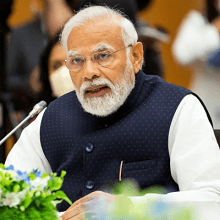Essay on Narendra Modi
Let us talk today about the 14th Prime Minister of India, Shri Narendra Modi. He was born to a grocery shop owner in a typical Gujarati family on September 17, 1950. He is one of the most famous faces of Indian politics. As of 2022, he has been the incumbent Prime Minister of India since 2014, after winning the elections in 2014. Earlier, Manmohan Singh was the Indian President. During his tenure as the Prime Minister, Mr Modi had many supportive people like Pranab Mukherjee, Ram Nath Kovind, Mohammad Hamid Ansari, etc. Recently, Draupadi Murmu was elected as the President, and Mr Modi congratulated her. His Lok Sabha Member of Parliament seat was preceded by Murli Manohar Joshi from the constituency of Varanasi. Before becoming the leader of the House (Lok Sabha), he was the 14th Chief Minister of Gujarat from October 7 2001 - May 22, 2014. It was later succeeded by Anandiben Patel, the first woman chief minister of the respective state. Birth, Education and BackgroundBorn in Vadnagar, known as the Mehsana district of Gujarat in the present day, Mr Modi was one of 6 siblings born to a family of Hiraben Modi and Damodardas Mulchand Modi. He belonged to the Hindu Modh-Ghanchi-Teli community, who were the oil pressers and were declared amongst the Other Backward Classes by the Government of India. He was the third eldest child in the family. However, his long political career has not spoken much about his family and its background. But, it was before the 2014's national elections that he focused on his lower-ranked social background and his working at his father's tea shop as a child. His father's tea stall was at the Railway station platform in Vadnagar. Modi's primary education was completed while working as his father's support at the shop. He passed the Higher Secondary exam in Vadnagar in 1967. His teachers had said him to be on average in studies but excellent in debate. They also put light on his interests in the theatre, where he used to like working on characters larger-than-life. At the age of eight, he came to know about the Rashtriya Swayamsevak Sangh (RSS). He actively participated in its proceedings and was a regular member of its training sessions (shakhas). He was made the organisation's balswayamsevak by Lakshmanrao Inamdar (usually called Vakil Saheb). He was known as the political mentor of Modi. While he was training, Modi came into contact with many other political leaders of Gujarat. Some notable leaders were Vasant Gajendragadkar, Nathalal Jaghda, etc. Modi received his BA degree in Political Science while doing distance learning in 1978 at Delhi University. He passed with the third class. After five years, in 1983, similarly, as an external distance learning student, he got his first-class Masters' degree from Gujarat University in political science. However, some controversy is also wrapped around his educational qualification. As it is known to all, child marriage was one of the standard practices in India in older times. Although due to the awareness spread by many governments, the age for marriage was later increased. But, following the old tradition, Modi's family engaged him when he was 18 years old with Jashodaben Chimanla, who was then 17 years old. But not popularly known, it is said that he never divorced her but left that relationship. They are still married but abandoned. Swami Vivekananda is said to have had a significant impact on Modi's life. Modi lives a much more disciplined life and profoundly believes in the need for work. It is, however, said that he is an introvert. Scholars and many biographers depict him as arrogant and charismatic but energetic. He is a vegetarian and has kept Badri Meena since 2002 as his cook. As seen, he is the most interactive Prime Minister, which was proved by the post he made on Google Hangouts on August 31, 2012, to interact with citizens on a live chat. He is also a fashion icon known for his ironed, half sleeves kurta. He is also known for one of his suits, which has his name embroidered on the pinstripes. This suit was worn by him when US President Barack Obama was on a state visit. Early Days in PoliticsModi had travelled for two years in North and Noth-east India. He has been to many of the Hindu Ashrams, such as that of Swami Vivekananda at Belur Math, Advaita Ashram of Almora, and Ramkrishna Mission of Rajkot. However, he didn't stay at any of the sites for a long time due to a lack of collegiate education. He had started working at his uncle's tea stall in mid-time. Later in 1971, Modi joined Atal Bihari Vajpayee's Jana Sangha Satyagraha, making the first political act done by Modi as an adult. This Satyagraha was somewhat connected to the Bangladesh Liberation War. But facing repression by the then Indira Gandhi government, Modi was put in the Tihar jail for a few days (a political war got initiated due to this, and a lot of RTIs were filed to the Prime Minister's Office, asking for details about his arrests). After the India and Pakistan War of 1971, Modi stopped working at his uncle's store and became a campaigner for the RSS under Inamdar. During "The Emergency", Modi was one of the many who went underground. The "Gujarat Lok Sangharsh Samiti" placed him as the general secretary, and it was a committee that used to coordinate with RSS. In 1978, he was made the RSS regional organiser for the region of Surat and Vadodara. He was promoted to work for RSS in Delhi the following year. Modi as Gujarat's Chief MinisterKeshubhai Patel was the Chief Minister of Gujarat before Modi. Modi replaced Keshubhai because of his weak health and reduced popularity among the public for poor performance in the Bhuj earthquake. Hence, Modi got elected to the legislative assembly in 2001. But questions were raised about him and his leadership after the 2002 Gujarat Riots. Although Special Investigation Team was appointed by the Supreme Court, no evidence was found as such to initiate a proceeding against him. Many western countries doubted his relationship with Muslims, so the United States of America barred him from entering the nation. He became the only person to be denied a US visa under the Commission on International Religious Freedom. The European Union and the UK had also refused his permission to enter. As he got into national politics, they all lifted the bans. It was in July 2007 that he became the person to hold the chair of Chief Minister of Gujarat for the longest period when he finished 2,063 consecutive days. Although his administration led to economic growth, it lacked in improving health, poverty and educational status and state statistics during his first tenure as the Chief Minister. He then boosted his administration and became popular in the state. In Modi's second term as the Chief Minister, the fuss from the government turned towards development from the Hindutva towards economic development. He remained the Chief Minister till 2014 when he had to resign from it after being appointed as the Prime Minister of India. Modi as Prime Minister of India
Despite the denial of some of the senior party leaders, he was made a face for the Prime Minister in the 2014 General Election. He led the party to a win with a majority in the lower house of the Parliament. When he took the oath as the Prime Minister of this country, he was the only Indian PM born after India's independence. It is, however, said that his administration looked into the Economic sector more and reduced investment in many of the social welfare initiatives. People say that although he improved bureaucracy's efficiency, he centralised the power by abolishing Planning Commission. But some initiatives, such as revoking Articles 370 and 35A, introducing the Citizenship Amendment Act and introducing three farm laws, had caused democratic instability. He had run many distinct movements. He initiated the sanitation and demonetisation campaign, transformed the taxing system, and relaxed environmental and labour laws. Modi's policy while being a Prime Minister is that he always tries to connect or interact with people through various means. This gives the people the incentives of the Prime Minster conversing with them. Hence, for this purpose, he holds the 'Man Ki Baat', a monthly radio program on 'All India Radio' and the 'Pariksha Pe Charcha' for interaction with students. On this December 06, 2020, he went on to be the only non - congress Prime Minister to serve for the longest tenure. In the 2019's Indian general election, Modi initiated the 'Main Bhi Chowkidar' slogan in opposition to the 'Chowkidar Chor Hai' slogan. In his second term, he was more focused on defence and national security development. Just before the elections, the Pulwama attack took place, and the Balakot airstrike was an immediate action by Indian Air Force. Hence, it was a topic in the run-to polls for him. It eventually helped him gain more popularity and support from the Indian public. State Honours given to ModiThe State honours given to Modi by various countries are as follows -
Awards and Recognition
Next TopicEssay on Parents
|
 For Videos Join Our Youtube Channel: Join Now
For Videos Join Our Youtube Channel: Join Now
Feedback
- Send your Feedback to [email protected]
Help Others, Please Share









